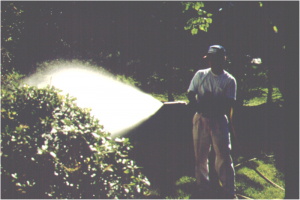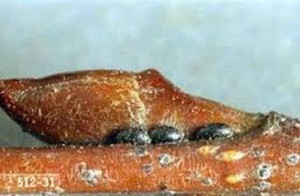In New Jersey, dormant oils (3-4%) are typically applied during March & April. However, many landscapers also apply dormant oils during the late fall months. Dormant oils have proven to be an effective material against a wide range of insect/mite pests & their eggs. Typical landscape pests targeted include spruce spider mites/eggs, southern red spider mites/eggs, oak spider mite eggs, aphid eggs, soft scales, armored scales (to a lesser degree), hemlock rust mites, spruce gall adelgids, lace bugs (deciduous plants), cankerworm eggs, psyllids, plant bugs, etc.
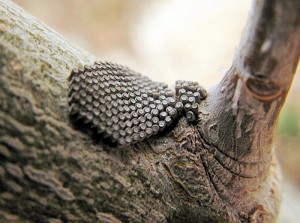
Some overwintering eggs such as Cankerworm eggs can be effectively destroyed by dormant oils.
Photo credit: Utah Extension.edu
Some landscapers have been successful applying both late fall & early spring dormant oil treatments to the same plants on the same properties. This is a reasonable approach since a single dormant oil application will not provide 100% control and it gives the field technician another opportunity to monitor the landscape for problems. Most oil applicators are aware that excellent spray coverage is the key to good controls. Some unofficial catch phrases to embrace when applying oil applications are, “look before you shoot” & “if it ain’t drippin’, then you’re slippin’.”
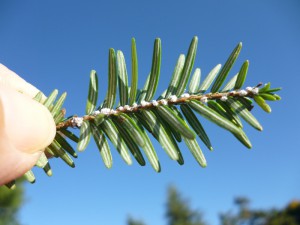
Dormant Oils can target overwintering Hemlock Wooley Adelgid females within the white waxy sacks. Eggs can also be targeted in March/April. Photo credit: SK Rettke

Eastern Spruce Gall Adelgid female stem mothers overwinter along lateral buds of newer branches. Photo credit: OMAFRA.gov.ontario
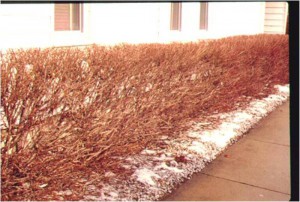
Two Spotted Spider Mites overwinter as females off the plant (Euonymus japonica) & dormant oils are not effective. Photo credit: SK Rettke
Some advisors within our industry have stated that fall dormant oil applications will increase the possibility for plant phytotoxicities. For example, it is warned that spraying oils on deciduous trees/shrubs just after leaf drop before plants have fully “hardened-off” can interfere with the interior growth of twigs, causing damage & even twig death. Also, it has been stated that spraying oils on conifers in November & December removes the protective waxy bloom necessary for winter protection, & therefore should be avoided. Be aware of some of the plants listed on the label that are sensitive to oils (e.g., junipers, Cryptomeria, arborvitae, Alberta spruce, etc.). In general, plants having hairy leaves are more sensitive since they retain the oil for a longer period of time. Finally, if the target pest is located on a plant that has experienced a lot of environmental stress, then wait until the early spring for treatment reassessment.
As a side note, usually all landscapers who apply oils know that conifers with foliage having a waxy, blue glaucous bloom (e.g., spruce & junipers) will have the bloom removed by oils. However, untreated new spring growth will develop the blue color & the glaucous bloom should eventually at least partially return again on the older needles within a year or two.
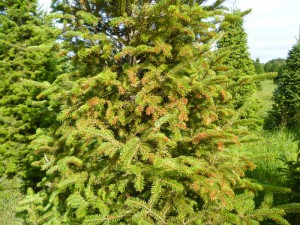
Phytotoxic burn to needles of Frasier Fir after an oil spray treatment. Photo credit: SK Rettke of RCE
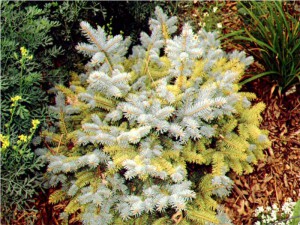
New growth is blue, but older needles were sprayed with a dormant oil in late winter. Photo credit: SK Rettke
Although the potential negative side effects need to be considered, they are typically not widespread problems. The use of a more conservative 2% oil mixture during the fall season on conifers may be a safeguard against undesirable side effects and yet still maintain spray efficacy. Dormant oils are best applied when temperatures will remain above 40° F. for at least 24 hours. When sprays are applied just prior to temperatures dropping below freezing, the emulsion breaks down, causing the oil to adhere to the bark/leaves instead of insects and therefore reducing results. However, several university studies determined that no phytotoxicity occurred at lower temperatures.
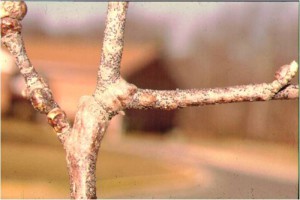
Black colored 2nd instar Tuliptree Scale nymphs overwinter on branch bark. With good coverage, dormant oils are effective. Photo credit: SK Rettke of RCE
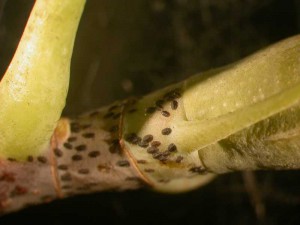
Close-up of overwintering Tuliptree Scale 2nd instar nymphs. Photo credit: Missouri botanical gardens.org
Nevertheless, fall dormant oil controls have some limitations. In addition to possibly better plant safety, it is important to note that early spring dormant oils will often provide superior results (i.e., insects/eggs are respiring more actively). Generally, whether fall or spring, dormant oil applicators need to remember that their treatments rarely give 100% controls & in some situations may actually provide poor results against many targeted pests.
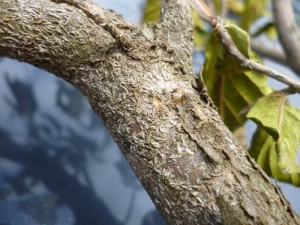
Japanese Maple Scales & other armored scales are a difficult control, but dormant oil sprays can provide some suppression. Photo credit: SK Rettke of RCE
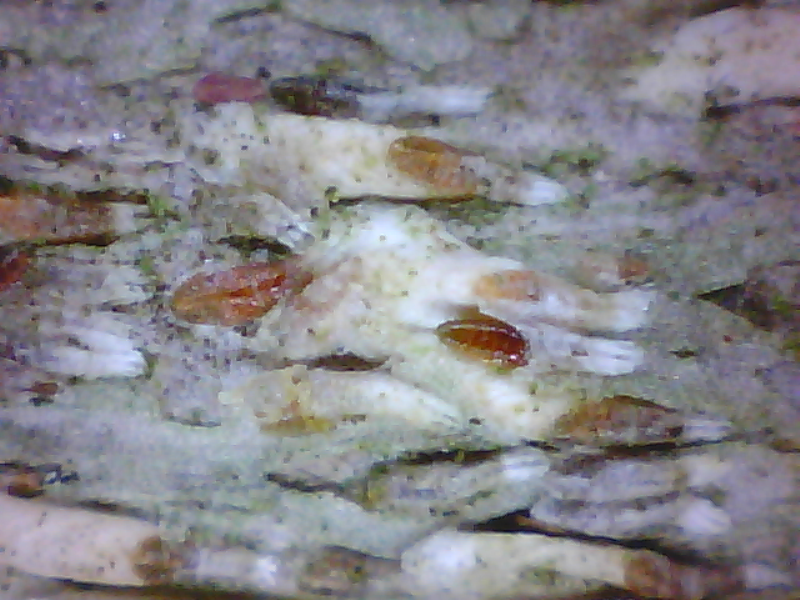
Close-up of Japanese Maple Scales. Removal of white, waxy scale cover will reveal the purple colored insect beneath. Photo credit: SK Rettke of RCE

Elongate Hemlock Scales are especially a difficult control with dormant oils. Crawler sprays or systemics (e.g., Safari) are most effective. Photo credit: SK Rettke of RCE
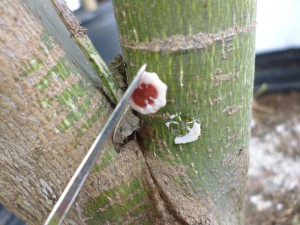
Indian Wax Scale is a soft scale that overwinters as mature nymphs or adults. The exceptionally thick body wax is difficult for oils to penetrate. Crawler sprays & systemics work best. Photo credit SK Rettke of RCE
Before applying dormant oils, monitor the plants to determine specific pest locations & to be sure the pests observed are susceptible to controls with oils. Properly direct the spray to where the pest is located on the plant (underside of foliage, bark, leaf buds, etc.). In order to prevent wasted sprays, only apply oils to targeted areas that have been scouted for pests. Avoid the common tendency of applying blanket dormant oil treatments to large block areas that may only possibly contain susceptible pests. Blind, blanket sprays of dormant oils will unlikely provide adequate coverage to achieve satisfactory controls. Such practices are actually irresponsible, especially in areas where there are no target pests. Remember, when applying pesticides (including dormant oils), “a prescription without diagnosis is malpractice.”

Southern Red Spider Mite Eggs overwintering at twig stem & under leaves of Pieris japonica. Carefully directed dormant oil sprays will give good results. Photo credit: SK Rettke of RCE
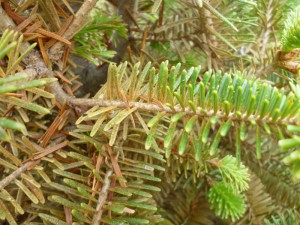
Spruce Spider Mites adults & eggs on this Frasier Fir may still be active as late as December. Target the outer growth with dormant oils for controls. Photo credit: SK Rettke of RCE
